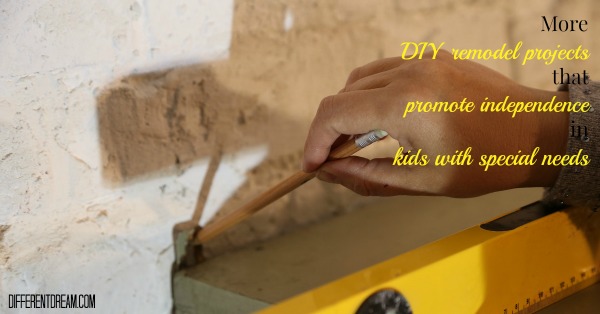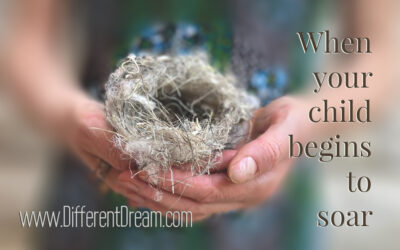Promote Independence in Kids with Special Needs, Pt. 2

Did you know you can promote independence in kids with special needs with some DIY home remodeling projects? Guest blogger Paul Denikin, handyman and dad to a child with special needs, shared 2 remodeling tips in last week’s post. Today he’s back with 2 more projects to encourage independence and confidence in your home.
Remodel to Promote Independence in Kids with Special Needs, Pt. 2
Tip #3: Make Bathrooms Safe and Accessible
Most home accidents occur in the bathroom, so it is especially important to make repairs and modifications to make the bathroom as safe and accessible as possible for your children with special needs. There are several products available that require minimal expense and effort that will make your bathroom more accommodating.
For example, you can install grab bars on the shower walls and near the toilet to aid your child with getting in and out of the shower and up and down from the toilet. Keep in mind that your child should not rely on towel racks, toilet paper holders, or wall-mounted sinks to support his weight; these products are not designed to do so, and your child could get injured if he attempts to use them. Other products that increase bathroom safety and accessibility include rubber grip mats for the floor of the bathtub, bathtub or shower seats, transfer tub benches, handheld shower heads, and raised toilet seats.
Of course, there are much more involved projects that you could undertake to remodel your entire bathroom for your child with special needs. Some families opt to install vanities and sinks at lower heights. Others opt to install shower stalls that are wheelchair accessible. The size and scope of your bathroom repair and modification projects depend on your child’s needs and your budget.
Tip #4: Ensure Your Floors Do Not Pose a Danger to your Child
High pile carpeting and tile flooring are not ideal for children with special needs. High pile carpeting prevents wheelchair wheels from turning and rolling properly, and tile floors may be uneven and result in your child tripping and falling as he walks. Tile floors also can inhibit wheel movement or the smooth movement of walkers and crutches if something catches on the corner of an uneven tile. Tile flooring in a bathroom or kitchen is dangerous because these surfaces tend to be very slippery when wet. Slip-resistant flooring is recommended for bathroom and kitchen installations, and it is worth noting that tiles no larger than 2” x 2” are less slippery than larger tiles.
Laminate or low pile carpeting is a better option for children with special needs. These flooring options are durable and work well in high-traffic areas and often are easier to clean than high pile carpet and tile floors. If your child has allergies or asthma, laminate and low pile carpet are better options for those health issues because they do not hold pet dander and dust like high pile carpet does.
There are several simple ways to modify your home to make it more accessible to children with special needs. From wheelchair ramps to slip-resistant floors, you can make the repairs and accommodations that promote independence in kids with special needs.
More Ideas that Promote Independence in Kids with Special Needs
Now that you’ve heard all of Paul’s ideas, it’s your turn. Add your DIY remodel ideas that promote independence in kids with special needs in the comment box below.
Do you like what you see at DifferentDream.com? You can receive more great content by subscribing to the quarterly Different Dream newsletter and signing up for the daily RSS feed delivered to your email inbox. You can sign up for the first in the pop up box and the second at the bottom of this page.

By Paul Denikin
Paul Denikin is passionate about sharing his experiences on his site dadknowsdiy.com with working on DIY projects to benefit people with special needs children.
Subscribe for Updates from Jolene
Related Posts
I Press On
Guest blogger Kelly Simpson explains how she leaned on God during times of adversity and was empowered to say, “I press on.”
The Empty Nest
Guest blogger Maggi Gale describes her utter joy at the empty nest she has after both her daughters have grown up and flown away.
Empowering Kids with Disabilities, Part 1: Meet Basic Survival Needs
Jolene explains how William Glasser’s choice theory taught her about enabling kids with disabilities to meet survival needs.






0 Comments